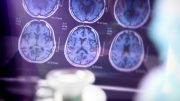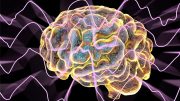
Increased sensitivity to light could disrupt the body’s biological clock and contribute to sleep disorders among people with Alzheimer’s disease, UVA researchers say. Credit: Illustration by Emily Faith Morgan, University Communications
A recent study from UVA Health on Alzheimer’s disease suggests that increased sensitivity to light might contribute to “sundowning” – the deterioration of the disease’s symptoms towards the end of the day – and spur sleep disruptions, which are believed to accelerate the progression of the disease.
The recent understanding of the biological clock disturbances associated with Alzheimer’s could be significant for devising treatments and managing symptoms, according to the researchers. Caregivers often find it challenging to deal with the unpredictable sleep schedules caused by the altered “circadian rhythms” or the body’s innate daily cycle in Alzheimer’s patients. The new study proposes that light therapy could potentially be a useful strategy to control these disruptions.

Dr. Heather Ferris, of the UVA School of Medicine, said the research suggests light therapy could help Alzheimer’s patients. Credit: University of Virginia
A better understanding of Alzheimer’s disease’s effects on the biological clock could also have implications for preventing the disease. Poor sleep quality in adulthood is a risk factor for Alzheimer’s, as our brains, when at rest, naturally cleanse themselves of amyloid beta proteins that are thought to form harmful tangles in Alzheimer’s.
“Circadian disruptions have been recognized in Alzheimer’s disease for a long time, but we’ve never had a very good understanding of what causes them,” said researcher Thaddeus Weigel, a graduate student working with Dr. Heather Ferris of the University of Virginia School of Medicine’s Division of Endocrinology and Metabolism. “This research points to changes in light sensitivity as a new, interesting possible explanation for some of those circadian symptoms.”
Alzheimer’s is the most common form of dementia, affecting 50 million people around the world. Its hallmark is progressive memory loss, to the point that patients can forget their own loved ones, but there can be many other symptoms such as restlessness, aggression, poor judgment, and endless searching. These symptoms often worsen in the evening and at night.
Ferris and her collaborators used a mouse model of Alzheimer’s to better understand what happens to the biological clock in Alzheimer’s disease. They essentially gave the mice “jet lag” by altering their exposure to light, then examined how it affected their behavior. The Alzheimer’s mice reacted very differently than did regular mice.
The Alzheimer’s mice, the scientists found, adapted to a six-hour time change significantly more quickly than the control mice. This, the scientists suspect, is the result of a heightened sensitivity to changes in light. While our biological clocks normally take cues from light, this adjustment happens gradually, as the body needs time to adapt. But for the Alzheimer’s mice, this change happened abnormally fast.
The researchers initially thought this might be because of inflammation in the brain, or “neuroinflammation.” So they looked at immune cells called microglia that have become promising targets in efforts to develop better Alzheimer’s treatments.

Researcher Thaddeus Weigel said the finding could aid in treating ”sundowning,” the tendency of dementia patients to become confused or show altered personality traits in the evenings. Credit: University of Virginia
While targeting microglia could be beneficial for other reasons in treating Alzheimer’s, the scientists ultimately ruled out the hypothesis, determining that microglia did not make a difference in how quickly mice adapted.
UVA scientists also ruled out another potential culprit: “mutant tau,” an abnormal protein that forms tangles in the Alzheimer’s brain. The presence of these tangles also did not make a difference in how the mice adapted.
The researchers’ results did suggest an important role for the retina in the enhanced light sensitivity in Alzheimer’s, giving them a promising avenue to pursue as they work to develop new ways to treat, manage and prevent the disease.
“These data suggest that controlling the kind of light and the timing of the light could be key to reducing circadian disruptions in Alzheimer’s disease,” Ferris said. “We hope that this research will help us to develop light therapies that people can use to reduce the progression of Alzheimer’s disease.”
Reference: “Altered circadian behavior and light sensing in mouse models of Alzheimer’s disease” by Thaddeus K. Weigel, Cherry L. Guo, Ali D. Güler and Heather A. Ferris, 20 June 2023, Frontiers in Aging Neuroscience.
DOI: 10.3389/fnagi.2023.1218193
The research was supported by the National Institutes of Health, the Owens Family Foundation, and the Commonwealth of Virginia’s Alzheimer’s and Related Diseases Research Fund.








Be the first to comment on "The Alzheimer’s Alarm: How Your Biological Clock Could Be Warning You"